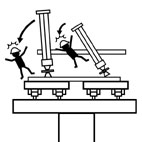| Case Name |
During a launching operation, a jack fell over, and an extended girder fell onto the bridge pier. |
| Pictograph |

|
| Date |
September 2, 1997 |
| Place |
Chitose City, Hokkaido |
| Location |
C lamp bridge at Chitose Junction, Hokkaido Crossing Driveway |
| Overview |
At the C lamp bridge construction site at Chitose Junction of Hokkaido Crossing Driveway, a bridge beam skidded while being launched, a jack fell over, an extended girder fell onto the bridge girder, and 6 workers got sacrificed and injured . |
| Incident |
Early on the morning of 2nd September 1997, an extended girder which was being launching fell onto the bridge pier, two workers who were crushed under the weight of the girder and one worker who fell from the bridge pier died, and other 3 workers got injured. |
| Sequence |
* The jack operation was carried out on the second pier (P2) in order to move a carriage behind the bridge beam, and the bridge beam was lifted and launched by hydraulic jack. Though the beam was intended to be moved by applying a load of 116tf, it would not move at all, and the bottom flange which was hit by the left jack on target to launch was distorted.
* When the beam was tried to be jacked down, it skidded suddenly.
* The beam was launched by using the backmost carriage as a supporting point, and it moved over 90 centimeters to the left on the third pier (P3), and the extended girder which was installed at the end of the beam fell onto the pier. |
| Cause |
* Though the specific reason why the beam greatly moved was not found, as the reason why a comparetively large horizontal force had been generated, there was an out-of -plane deformation (dent) of the flange under the bridge beam, which arose during the P2 jack operation. It seemed that the reason for the deformation had arisen because the jacking-up operation was done at the position which deviated from the part reinforced by a vertical stiffener, and the jack could not support the beam except only at a part of the jack.
* The bottom face of the jack might partially float because of the temporary cradle which supported the jack had sunk.
* In the case that these phenomenons arise at a time, it is considered notionally that comparatively large horizontal force would be applied on the beam by the eccentricity of the reaction force of the jack.
* This might be attributed to the simultaneous operation of the P2 jack and the P3 jack and the restraint of the beam, which is generated by the difference between the launching direction and the linearity of the rail for the carriage. It seems that the cross direction force beyond expectation arose because these several factors were interwoven. |
| Countermeasures |
* The jack was fixed to the cradle for preventing it from falling down.
* The temporary cradle was strengthened, and the equipment which fixed the beam against skidding was used. |
| Knowledge Comment |
* Recognize the content of the building plan.
* Remove all the risk factors. |
| Background |
Though it is the direct cause of this accident, there seemed to be a safety problem like the following.
* In this field, the stopper was installed at P3 in order to prevent the excessive lateral motion of the middle girder, but the stopper at the left side in the launching direction was temporarily removed at the time of the accident.
* Measures for safety and measures to prevent workers from falling were never prepared. |
| Reason for Adding to DB |
For preventing the same kind of construction disaster from coming about |
| Scenario |
| Primary Scenario
|
Insufficient Analysis or Research, Insufficient Prior Research, Carelessness, Insufficient Precaution, Misjudgment, Misjudgment of Situation, Non-Regular Movement, Movement During Transition, Non-Regular Operation, Change in Operation, Failure, Fracture/Damage, Bodily Harm, Death
|
|
| Sources |
Measures for preventing a recurrence learning from 70 examples of grave accident - construction accidents - , Nikkei Construction
|
| Number of Deaths |
3 |
| Number of Injuries |
3 |
| Physical Damage |
unknown |
| Financial Cost |
unknown |
| Economic Loss |
unknown |
| Field |
Civil Engineering
|
| Author |
TANAKA, Nobuyuki (Japan Engineering Consultants Co., Ltd.)
|
|